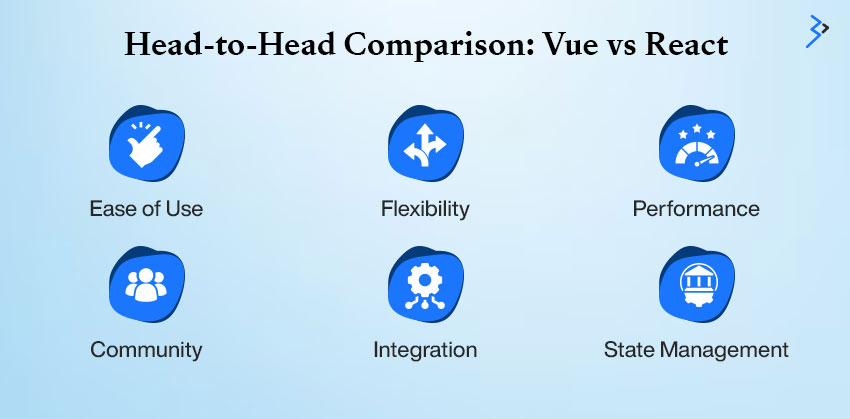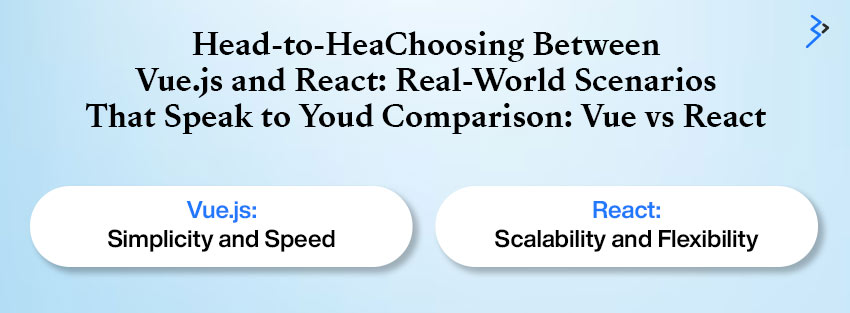Table of contents
2. What is Vue.js?
3. What is React?
4. Pros and Cons
5. Head-to-Head Comparison: Vue vs React
6. Factors to Consider Before Choosing
7. Choosing Between Vue.js and React: Real-World Scenarios That Speak to You
8. Expert Recommendations
Wrap Up!
FAQs
Choosing the proper library for web development is essential because it affects the application's performance and the development process. React is a JavaScript toolkit for creating UI components using JSX.
At the same time, Vue is a progressive framework that utilizes HTML templates and has additional built-in features for state management and routing. React's component-based approach primarily relies on third-party libraries, but Vue offers an integrated ecosystem, making it simpler for developers to begin constructing whole apps.
Vue and React are the most popular JavaScript technologies, making them top choices for building highly resilient and scalable applications. React holds a 39.5% market share, while Vue.js has 15.4%. Both are widely used, capable of delivering similar results, and trusted by successful companies. However, each has unique features that impact ideal use cases, implementation time, and the learning curve. Consequently, the competition between Vue and React is intense.
Source - https://gist.github.com/tkrotoff/b1caa4c3a185629299ec234d2314e190
React is well-known for its robust ecosystem and widespread popularity. As the most recognized JavaScript technology, it offers countless free tools, libraries, and educational resources. If comprehensive functionality is more important than efficiency, consider hiring a React.js development firm.
Choosing between Vue and React is often difficult since both address comparable difficulties while giving various techniques to solve them.
But how can you determine which is best for you? Whether you're a company founder trying to create your first application, a seasoned developer searching for new tools, or a project manager looking to improve team efficiency, this tutorial is for you. Let's break it down step by step.
2. What is Vue.js?

Vue.js is the brainchild of Evan You, who envisioned a framework that combined the best parts of Angular and React while being lightweight and flexible. Since its debut in 2014, Vue has gained a reputation for being intuitive and developer-friendly, making it a favorite for those who want to get up and running quickly without a steep learning curve.
Key Features and Strengths
- Simplicity: Vue’s core library is straightforward, focusing on the view layer. This makes it ideal for both beginners and experts.
- Two-Way Data Binding: Vue’s reactivity system ensures seamless synchronization between the model and the view, reducing boilerplate code.
- Built-in Solutions: With features like transitions, animations, and state management already integrated, Vue minimizes reliance on external tools.
Use Cases
Vue’s versatility shines in projects of all sizes, but it particularly excels in:
- Progressive Web Apps (PWAs)
- Single-Page Applications (SPAs)
- Enhancing existing application functionalities
- Large-scale enterprise solutions
Real-World Applications
- Grammarly: Vue powers its intuitive editor with dynamic data binding and a clean template syntax.
- Behance: Developers use Vue to add visual features seamlessly while maintaining code uniformity.
- Adobe Portfolio: Vue enabled a smooth migration from a legacy framework while safeguarding data integrity.
A passionate community supports Vue’s ecosystem, though its smaller size than React’s can pose challenges for those tackling complex, large-scale problems. Despite this, Vue’s simplicity and performance optimization make it an excellent choice for small- to medium-sized projects.
3. What is React?
React is a powerhouse framework backed by Meta (formerly Facebook). Introduced in 2013, it revolutionized web development with its component-based architecture and declarative programming style. React’s key philosophy is to “build user interfaces by breaking them into reusable pieces,” making it a favorite for complex, scalable applications.
Key Features and Strengths

- Component-Driven Architecture: Encourages the creation of reusable and modular components, reducing code redundancy and simplifying updates.
- Virtual DOM: Enhances performance by updating only the necessary parts of the DOM instead of reloading the entire page.
- Flexibility and Ecosystem: React’s flexibility is unparalleled, but it’s often paired with additional libraries (like Redux for state management) to handle complex needs.
Use Cases
React’s design makes it ideal for:
- High-performance Single-Page Applications (SPAs)
- Enterprise-grade applications with complex state management
- Applications requiring advanced UI interactions
Real-World Applications
- Instagram: A seamless experience with real-time updates and dynamic content.
- Netflix: Smooth video streaming and an intuitive user interface built for scalability.
- Uber: Optimized for real-time requests and location-based services.
React’s large, global community ensures abundant resources and plugins, but its steep learning curve (thanks to JSX and frequent updates) can be daunting for newcomers. Despite these challenges, React’s robustness makes it a top choice for enterprise applications.
4. Pros and Cons
| Aspect | React | Vue |
| Pros | Efficiency: React apps refresh only the required data, speeding up page loads | Ease of Integration: Vue can be gradually introduced into projects |
| Reusability: Modular components make building and maintaining apps more efficient | Lightweight: Faster performance with minimal overhead | |
| Large Community: A vast ecosystem of tools, libraries, and support | Built-In Solutions: Out-of-the-box features like animations and state support | |
| High Performance: Virtual DOM and optimized rendering ensure smooth performance | Progressive Framework: Suitable for both small and large projects | |
| Cons | Frequent Updates: Keeping up with React’s updates can be challenging | Community Size: Smaller than React’s, with some language barriers in documentation |
| Learning Curve: JSX can be intimidating for beginners | Flexibility Risks: Too many options can lead to inconsistencies in code | |
| View-Only Framework: Additional tools are needed for state management and routing | Resource Limitations: Fewer third-party plugins compared to React |
5. Head-to-Head Comparison: Vue vs React

| Factor | Vue | React |
| Ease of Use | Beginner-friendly, intuitive | Flexible but steeper learning curve |
| Flexibility | Opinionated, cohesive tools | Modular, highly customizable |
| Performance | Optimized for straightforward tasks | Excels in dynamic scenarios |
| Community | Smaller, dedicated | Large, resource-rich |
| Integration | Simple CLI, great for legacy apps | Versatile, requires more setup |
| State Management | Vuex: Seamless with Vue | Redux: Versatile but complex |
When choosing between Vue.js and React, understanding their key differences can help you decide which is right for your project. Let’s break it down into bite-sized comparisons that directly address your concerns.
Ease of Use: Learning Curve for Beginners and Experienced Developers
- Vue:
- It is designed to be intuitive and beginner-friendly.
- Clear documentation and structure make it an excellent choice for those just starting out with front-end development.
- Its simplicity allows experienced developers to quickly prototype and build applications without being bogged down by unnecessary complexity.
- React:
- It offers more flexibility, but this can come at the cost of a steeper learning curve for beginners.
- More complex applications require understanding additional concepts, such as JSX, props, and state management libraries like Redux.
- Experienced developers often appreciate React's freedom, enabling them to tailor solutions to specific needs.
Flexibility & Customization
- React:
- Known for its modularity and unopinionated nature. You can mix and match libraries to fit your exact needs.
- This flexibility is a double-edged sword: it’s powerful but overwhelming for beginners who might not know the best practices.
- Vue:
- More opinionated with built-in solutions for common tasks like state management and routing.
- This “batteries-included” approach provides a cohesive experience but might limit developers looking for extreme customization.
Performance: Virtual DOM Differences and Rendering Speed
Both Vue and React utilize a virtual DOM, which boosts rendering efficiency by updating only the parts of the DOM that change.
- React:
- It employs a more complex reconciliation algorithm, which can be slightly slower in some scenarios but shines in highly dynamic applications.
- Vue:
- Optimized for performance with a more straightforward virtual DOM implementation, often yielding faster updates in less complex applications.
Community & Ecosystem
- React:
- Facebook backs it and boasts a massive community, ensuring abundant resources, tutorials, and third-party libraries.
- Its larger ecosystem means you’ll likely find solutions to most challenges.
- Vue:
- While smaller, Vue’s community is highly dedicated and supportive.
- The official ecosystem includes high-quality tools like Vue Router and Vuex, reducing the need for third-party solutions.
Integration & Compatibility
- Vue:
- It comes with the Vue CLI, simplifying project setup and offering a plug-and-play experience.
- Seamlessly integrates with existing projects, especially for adding components to legacy applications.
- React:
- It utilizes the Create React App for a streamlined setup.
- Its flexibility allows for integration into various environments, but setting up advanced configurations may require additional effort.
State Management: Vuex vs Redux
- Vue (Vuex):
- Tailored to work seamlessly with Vue, offering an intuitive and declarative API.
- Best for applications with straightforward state requirements and Vue-centric projects.
- React (Redux):
- It is more versatile but can be verbose and complex.
- Supports non-React projects, making it an excellent choice for developers familiar with multiple frameworks or needing advanced state management capabilities.
6. Factors to Consider Before Choosing
Picking the right framework isn’t about which is “better”; it’s about aligning with your project’s goals, your team’s expertise, and future scalability. Here are some key factors to weigh:
The Scale of the Project
- Small Projects/Startups:
- Vue’s simplicity and out-of-the-box features make it ideal for quickly spinning up small-scale applications.
- React is equally capable but may require more upfront configuration for simple projects.
- Enterprise-Level Applications:
- React’s extensive ecosystem and scalability make it a strong choice for large, complex applications.
- Vue can handle enterprise needs, too, but finding enterprise-level resources and support may be slightly more challenging.
Developer Expertise and Team’s Tech Stack Preferences
- If your team already has experience with JavaScript frameworks:
- Vue might feel more natural for developers familiar with Angular or traditional templating systems.
- React appeals to developers who prioritize flexibility and customization.
- For teams without much experience, Vue’s straightforward approach might reduce the learning curve and improve productivity from day one.
Long-Term Maintenance and Scalability Requirements
- React:
- Provides greater flexibility for evolving your application’s architecture over time.
- The extensive community ensures ongoing support and resources.
- Vue:
- Its simplicity can lead to faster development cycles, but it might have limitations for highly complex or long-lived projects.
Need for Community Support or Pre-Built Solutions
- A strong community can save you countless hours. React’s larger ecosystem means:
- More plugins, libraries, and tools are readily available.
- It is easier to find answers to problems via forums, blogs, or Stack Overflow.
- While Vue’s community is smaller, it is tightly knit and highly supportive. Vue’s curated ecosystem might be a better fit if you prefer official solutions over third-party tools.
7. Choosing Between Vue.js and React: Real-World Scenarios That Speak to You

When deciding between Vue.js and React, you’re not just picking a framework—you’re solving real problems. To help you connect the dots, let’s dive into practical examples that highlight how these technologies shine in the real world.
Vue.js: Simplicity and Speed
Vue.js is your go-to when you need fast, straightforward solutions that deliver great results. It excels in scenarios like:
Lightweight Applications
Vue.js delivers the speed and efficiency needed for simple yet impactful projects such as personal portfolios, blogs, or dashboards.
Example:
- Company Website: Louis by Louis, a French pastry brand, built its elegant website using Vue.js. It showcases products while maintaining fast load times and a sleek design.
Single-Page Applications (SPAs)
Vue.js is ideal for SPAs that must perform smoothly while being simple to set up.
Example:
- Event Management App: A local event organizer developed a guest list and RSVP management app with Vue.js. This streamlined event planning while keeping the interface user-friendly.
Small to Medium Projects
Teams working on smaller-scale projects often turn to Vue.js for its simplicity and quick learning curve.
Example:
- Project Management Tool: Alibaba used Vue.js to create lightweight tools for small business teams to manage tasks without the complexity of larger systems.
React: Scalability and Flexibility
React shines when you’re building for the long term, offering robust solutions for complex needs. It’s perfect for:
Complex UIs
React’s flexibility suits dashboards and analytics tools with intricate user interactions.
Example:
- E-Commerce Platform: Shopify employs React to manage dynamic filtering, personalized recommendations, and a seamless checkout experience for its global user base.
Cross-Platform Applications
React Native allows you to reuse code across platforms, cutting development time for mobile and web apps.
Example:
- Social Media App: Facebook used React Native for Instagram, enabling a consistent user experience across iOS and Android.
Large-Scale Projects
React’s ecosystem and scalability make it a favorite for enterprises planning for growth.
Example:
- Streaming Service: Netflix uses React for its front end to handle complex UIs while maintaining performance across millions of users worldwide.
Your Decision: Start with Your Problem
The choice between Vue.js and React isn’t about which is better—it’s about what fits your needs. Are you building something simple and fast or planning for massive scalability? By focusing on your specific goals, you can choose the framework that’s perfect for you.
8. Expert Recommendations
When selecting a framework, aligning it with your project goals and team expertise is key. Here are tailored recommendations to guide your decision:
When to Choose Vue.js
- Quick Development: You need to build an app in record time.
- Smaller Teams: Best for teams that value simplicity and minimal configuration.
- Beginner-Friendly: Your team includes developers new to JavaScript frameworks.
- Simplicity is Key: Suitable for projects where straightforward design and functionality are the focus.
When React Stands Out
- Customization Needs: You’re working on a project requiring highly flexible and reusable components.
- Complex UIs: For apps demanding advanced interactivity and state management.
- Large-Scale Projects: When scalability and performance optimization are priorities.
- Cross-Platform Development: Your project includes both web and mobile apps.
Wrap Up!
Choosing the right framework can make or break your project’s success. Vue.js and React are powerful tools, but they serve different purposes. Let’s recap:
- Vue.js: A lightweight and beginner-friendly framework for smaller projects or SPAs where simplicity and speed matter.
- React: A robust, scalable react solution for complex applications with intricate UIs or cross-platform requirements.
The key is to align the framework with your project’s unique requirements and your team’s expertise. Not sure which to pick? Connect with our experts to ensure you’re starting on the right foot.
FAQs
1) What are the key differences between Vue.js and React?
Vue.js focuses on simplicity and fast development with a smaller ecosystem, while React offers greater flexibility, scalability, and a larger community.
2) Which framework is better for beginners: Vue.js or React?
Vue.js is often considered more beginner-friendly due to its intuitive syntax and easy learning curve. React’s steep learning curve suits developers aiming for long-term mastery.
3) Is Vue.js better suited for smaller projects, while React is ideal for larger ones?
Yes, Vue.js shines in smaller projects, emphasizing simplicity and speed. React’s scalability and flexibility make it the better choice for larger or more complex applications.
4) How do Vue.js and React handle state management?
Vue.js uses Vuex for centralized state management, focusing on simplicity. React relies on Redux or Context API, offering greater flexibility for managing complex states.
5) Can I switch from Vue.js to React or vice versa during a project?
Switching is possible but challenging, as it may involve reworking architecture and code. It’s best to evaluate frameworks carefully before starting development.
Related Articles
Digital Transformation
Hyper-Personalized Banking: Driving Customer Loyalty and Engagement with AI-Powered Adobe Experiences
Digital Transformation
Leveraging 3rd Party LLMs: A Guide to Commercial AI Platforms
Digital Transformation
AI-Driven Security: Protecting Your eCommerce App and Customer Data in an Evolving Threat Landscape


